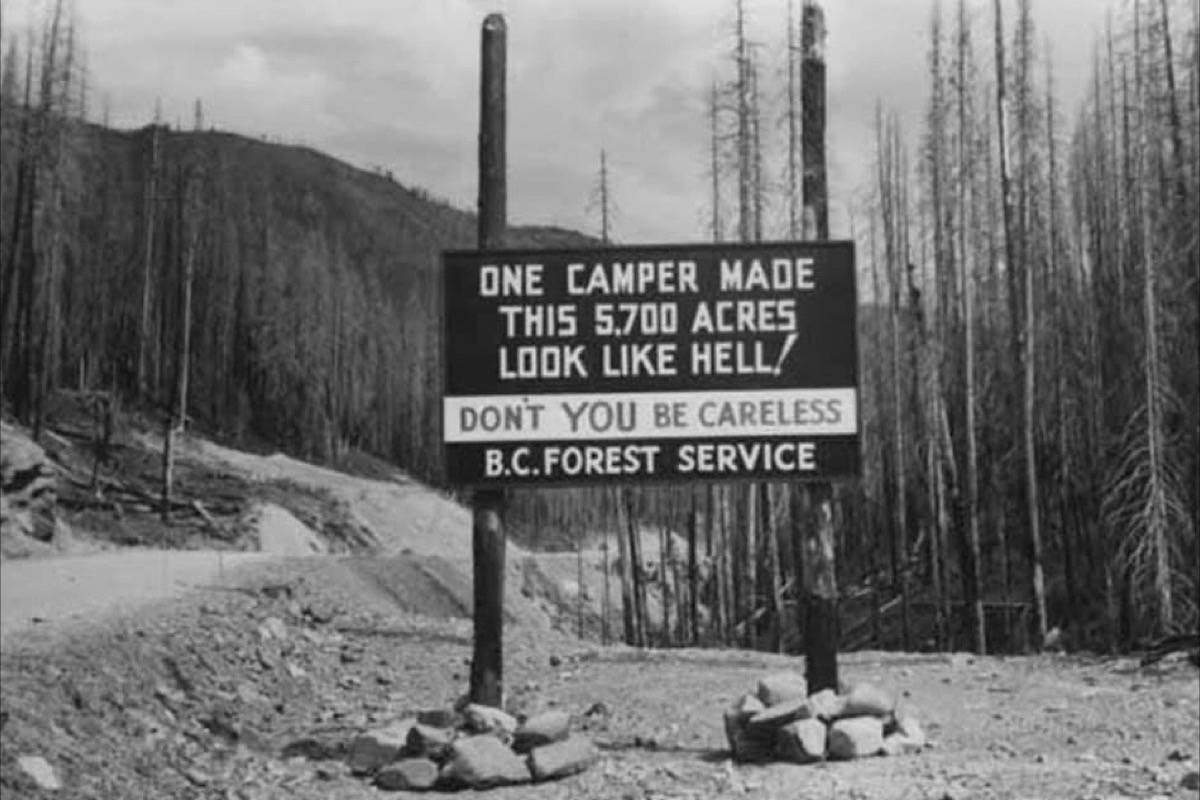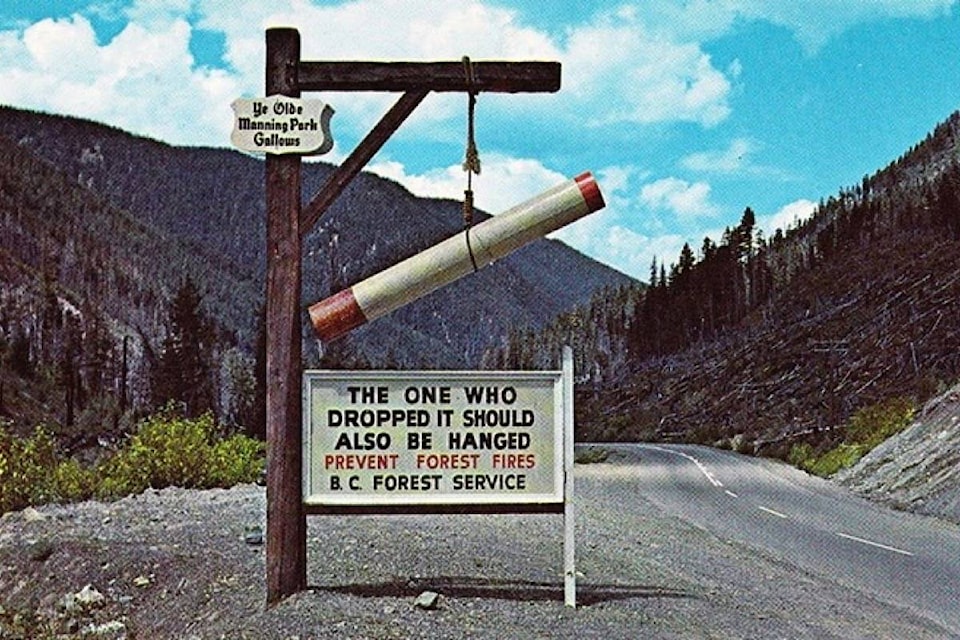In the summer of 1950, one of the most eye-catching highway signs of all time was erected beside a B.C. highway, and soon became as much of an attraction as the park that stood nearby.
When E.C. Manning Provincial Park was established in 1941, it was described as a “holiday land without peer” whose gateway was “a mere jaunt by auto or train from Vancouver”. There was only one problem: while a highway linking Hope and Princeton — 27 miles of which were to run through the park — was supposedly imminent, it had not yet been built, and would not be completed until 1949.
Even when the highway was finally built, however, there was a major problem. The western approach to the park was through a heavily treed area that was particularly susceptible to fire, and in August 1946 a campfire left unattended in the park (either by campers or copper miners; sources vary) had burned out of control for more than three weeks.
The result was nearly 6,000 acres of scorched land at Manning Park’s western entrance way, with the highway running right through it. There was no way of hiding the devastation from the eyes of passing motorists, and even if the area was reforested, it would be years before the scars from the fire would be softened. One observer who saw the site from the air in 1946 said that the burnt area would be “a most conspicuous feature, in full view of any person driving through the park.”
This was not the “holiday land without peer” image that park staff wanted to convey. They concluded that the area of the “Big Burn”, as it came to be known, was such a “frightful, desolate sight” that some kind of explanation was needed. Two Parks Division employees — Chester “Ches” Lyons and Mickey Trew —put their heads together, and came up with a solution that was as dramatic as it was simple: a sign reading ONE CAMPER MADE THIS 5,700 ACRES LOOK LIKE HELL! DON’T YOU BE CARELESS, which was erected beside the highway at the western edge of the Big Burn in spring 1950.
The intention of the sign was clear: explain why the Big Burn site looked the way it did, and urge people to be careful with fire in the back country. The message was one of the earliest attempts at a public campaign to prevent forest fires, but while the aim of the sign could not be faulted, the Dept. of Public Works objected to it on two grounds: they had not given permission for it to be put up on their highway right-of-way, and (according to Lyons) they felt that the word “hell” was too strong to be displayed publicly.
The sign was taken down, but if Public Works had hoped that was the end of the matter they were sadly mistaken. A replacement sign went up in summer 1950: a huge gallows, from which dangled a 10-foot-long cigarette in a noose. A small sign on the upright read “Ye Olde Manning Park Gallows”, and below the cigarette was a much larger sign with a stark message: THE ONE WHO DROPPED IT SHOULD ALSO BE HANGED. (The wording originally used the word “guy”, which was later replaced with “one” so that it was not gender specific).
Subtle it was not (and the Big Burn had not been caused by a carelessly discarded cigarette), but it certainly got people’s attention, and for a time was probably the most famous of all Manning Park’s attractions. “This was a car-stopper for sure!” Lyons recalled. “It was photographed and displayed in magazines near and far. I don’t think there has ever been a forest fire sign with more impact than that one.” Park Superintendent Bob Boyd reported the “clicking of cameras” at the sign all summer.
Whether or not any members of the public had complained about the use of the word “hell” on the first sign is not known, but public reaction to the gallows was overwhelmingly positive, and Boyd decided that the sign would remain, permission or no permission. Writing to Parks Division headquarters in the fall of 1950, Boyd feigned ignorance of the sign’s origins.
“We have not been informed who or what Department was responsible for this type of sign; perhaps it does not matter,” he noted, tongue probably firmly in cheek. He went on to state that the sign would be removed over the winter “in order that the gospel of Forest Protection may continue next summer.”
The Manning Park Gallows did indeed go back up in 1951, and while the Dept. of Public Works never gave permission for it to be on the right-of-way, they turned a blind eye to it. The sign remained a fixture at the western edge of Manning Park until 1963, by which time much of the Big Burn site visible from the highway had been cleared and re-seeded. With the seedlings starting to grow it was felt that the Manning Park Gallows sign had served its purpose, so it was taken down.
It has also been theorized that growing opposition to capital punishment had something to do with the decision to remove the Manning Park Gallows sign. The last execution (by hanging) in Canada was in December 1962, and starting with the election of the Liberals under Lester B. Pearson in April 1963 the federal government commuted all death sentences as a matter of policy. The death penalty was officially abolished in 1976.
Although it is long-gone, memories of the famous gallows sign linger on in the minds of those who drove the Hope-Princeton Highway between 1950 and 1963. It was an effective early attempt at educating the public about the dangers of forest fires, and today signs reminding motorists to be careful with fire are a common sight on B.C.’s highways, even if none of them are as striking and memorable as the Manning Park Gallows.
editorial@accjournal.ca
Like us on Facebook and follow us on Twitter

